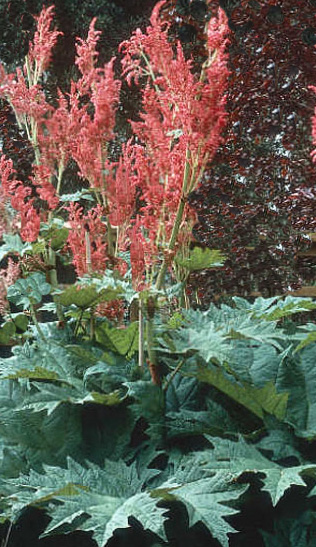 Rubarb (Rheum spp) is a genus of about 60 species and in the buckwheat family, Polygonaceae, that includes sorrel, sea grape, and the pesky Japanese knotweed. Rheum species have large deciduous triangular leaves with long fleshy stems (petioles) and although the leaves are toxic, the petioles are not. The flowers are small and carried in leafy panicles . Some species have been cultivated for their herbal qualities, others for food, and still other for their ornamental value in the garden. Rubarb likes fertile, moist soil and plenty of direct light. It is generally cool weather plant but hardiness varies with the species.
Rubarb (Rheum spp) is a genus of about 60 species and in the buckwheat family, Polygonaceae, that includes sorrel, sea grape, and the pesky Japanese knotweed. Rheum species have large deciduous triangular leaves with long fleshy stems (petioles) and although the leaves are toxic, the petioles are not. The flowers are small and carried in leafy panicles . Some species have been cultivated for their herbal qualities, others for food, and still other for their ornamental value in the garden. Rubarb likes fertile, moist soil and plenty of direct light. It is generally cool weather plant but hardiness varies with the species.
Shakespeare mentions rhubarb in Macbeth (act v, sc. 3, 55) when Macbeth is preparing to defend his castle against the English and asks the doctor;
What rhubarb, senna, or what purgative drug,
Would scour these English hence?
Rhubarb has been cultivated for over four thousand years. The Chinese had a rhubarb , Reum palmatum, also known as Turkish rhubarb, that was famous for the purgative qualities of its root. Marco Polo may have brought the plant to Europe in the thirteenth century but it was probably not known in Britain for another hundred years. The London apothecary, John Parkinson writing in the beginning of the seventeenth century mentions it but Shakespeare probably only knew it by reputation. Chinese rhubarb is still grown for its medicinal qualities as is Rheum officinalis, but it is also an excellent garden plant because of its impressive size. The edible rhubarb used for pies is Rheum rhabarbarum or Rheum x hybridum.